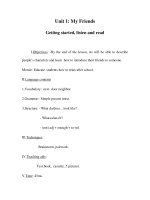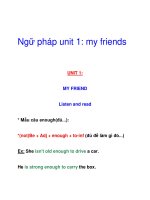Tải Giáo án Tiếng Anh 8 Unit 1: My friends - Giáo án điện tử Tiếng Anh 8
Bạn đang xem bản rút gọn của tài liệu. Xem và tải ngay bản đầy đủ của tài liệu tại đây (140.16 KB, 17 trang )
<span class='text_page_counter'>(1)</span><div class='page_container' data-page=1>
<i><b>GIÁO ÁN TIẾNG ANH 8</b></i>
<b>Unit 1</b>
<b>My friends</b>
<b>Period 2 Lesson 1: Getting started </b>
<b> Listen and read </b>
<i><b>A/Aims and objectives: By the end of the lesson, Ss will be able to know more about Hoa LAN _</b></i>
<i>Nine and read the dialogue for details and review simple present and simple past tenses.</i>
<i><b>B/Teaching aids: Text books, cards, cassette, chalk...</b></i>
<b>C/Procedure: </b>
<b>time</b> <b>Teacher’<sub>s activities</sub></b> <b><sub>Students</sub>,<sub>activities</sub></b>
<b>I/Warm up: Pelmanism </b>
meet come live think send thought
receive met lived received came sent
- Remark and lead in new lesson.
<b>II/Presentation:</b>
<i>1. Pre- reading </i>
a) Pre- teach vocabulary: Introduce the aims and some
new words
- to seem (translation)
- a next door neighbor: a person who lives next to your
house.
- to look like (translation)
* Checking vocabulary: Rub out and remember
b) Pre- questions
- Give Ss some questions and ask them to work in pairs
to answer them
1. Is Nien Lan,<sub>s friend or Hoa</sub>,<sub>s friend?</sub>
2. How old is Nien?
3. Where does Nien live?
4. Is she a beautiful girl?
- Give feedback
<i><b>2. While – reading: </b></i>
- Turn on the tape 2 times and ask them to read the
dialogue between Hoa, Lan and Nien. Then check if
Work in groups.
Listen and write down.
Listen and repeat in chorus
and individually.
Guess its meanings.
Copy down.
Play game in whole class.
Work in pairs.
</div>
<span class='text_page_counter'>(2)</span><div class='page_container' data-page=2>
their answers are correct or not
Answers:
1. She is Hoa,<sub>s friend.</sub>
2. She is 12 years old.
3. She lives in Hue.
4. Yes, she is.
<b>a) Comprehension questions </b>
- Ask Ss to read the dialogue again and answer the
questions in exercise 2/page 11
- Have them work in pairs to answer the questions
- Call on some pairs to demonstrate in front of class
and correct their mistakes or pronunciation.
- Correct and give feedback:
a) She lives in Hue
b) No, she does not.
c) The sentence is “ She was not old enough to be in
my class. “
d) At Christmas
- Ask them to work in open pairs to practice asking
and answering the questions and the dialogue.
<b>b) Gap filling </b>
- Ask Ss to use the present simple and simple past tense
to complete the paragraph, using some verbs: live –
send – be – come
<i> Hoa... in Hue last year, but now she....in Ha Noi. </i>
<i>Yesterday, Hoa,s friend Nien... Hoa a letter. Nien... </i>
<i>Hoa,<sub> neighbor when Hoa lived in Hue. She... younger </sub></i>
<i>than Hoa. She... to Ha Noi in December. </i>
- Get Ss to work individually and then compare their
answers with their partners.
- Give feedback
lived – lives – sent – was – is - comes
- Call on some Ss to read the completed paragraph in
front of class.
<i><b>3. Post - reading: Writing </b></i>
- Ask Ss to write a paragraph about Hoa and Lan.
Repeat all the correct answers
and copy down
Work in pairs
Demonstrate in front of class.
Practice asking and
answering the questions and
the dialogue.
Complete the paragraph
individually.
</div>
<span class='text_page_counter'>(3)</span><div class='page_container' data-page=3>
- Give Ss some cues and ask them to use the simple
present or past tense to write individually.
<b>* Cues:</b>
<i>a. Lan/Hoa,<sub>s best friend </sub></i>
<i>b. They/same class/Quang Trung School.</i>
<i>c. Last year/Hoa/to school first time.</i>
<i>d. Lan/show/round/introduce/to new friends.</i>
- Let Ss discuss with their partners.
- Choose some answers and correct them in front of the
class.
<b>III/Home work: </b>
1. Rewrite all the answers and complete paragraph on
their notebooks.
2. Do Exercise...in workbook.
3. Prepare the next lesson.
Write a paragraph about Hoa,
Lan
Demonstrate in front of class.
Listen and copy
<b>Unit 1</b>
<b>My friends</b>
<b>Period 3 Lesson 2: Speak </b>
<i><b>A/Aims and Objectives: By the end of the lesson, Ss will be able to describe someone.</b></i>
<i><b>B/Teaching aids: Textbooks, pictures, chalks...</b></i>
<b>C/Procedure : </b>
<i><b>I/Warm up: Brainstorming </b></i>
- Ask Ss to think of the adjectives used to describe body
build and hair.
<b>II/Presentation: </b>
- Show Ss a picture of Mary and ask them to describe her
hair, her body build.
Ex: She has long blond hair.
She is short and thin.
<b>Form S + have/has + adjective + hair </b>
<b> S + be + adjectives </b>
<b>III/Practice : </b>
1. Word cue drill
- Prepare 6 cards so that students can drill easily.
</div>
<span class='text_page_counter'>(4)</span><div class='page_container' data-page=4>
a. He/tall/thin.
b. She/short/slim.
c. He/short/fat.
d. Long/black.
e. Curly/blond.
f. Straight/brown.
- Ask Ss to read their complete sentences aloud.
- Correct and give feedback.
a. He is tall and thin.
b. She is short and slim.
c. He is short and fat.
d. She has long black hair.
e. She has curly blond hair.
f. She has straight brown hair.
2. Practice speaking
- Ask Ss to look at six people in their books.
- Call on a student to describe one person, the others have
to guess who he/she is.
* Example:
S1: This person is short and thin. She has long blond hair.
S2: Is this Mary?
Yes
- Go on until six people on the poster are described
<b>IV. Post speaking: Writing </b>
- Ask Ss to write all the sentences they have described
above.
<b>V/Homework: </b>
1. Copy all the right sentences above.
2. Do the exercises in workbook.
3. Prepare the next lesson.
Read all the adjectives
aloud.
Look at the picture and read
the example aloud
</div>
<span class='text_page_counter'>(5)</span><div class='page_container' data-page=5>
examples.
Work individually
Read the sentences aloud.
Practice speaking in front
of class.
Write their sentences alone
Listen and copy.
<b>Unit 1</b>
<b>My friends</b>
</div>
<span class='text_page_counter'>(6)</span><div class='page_container' data-page=6>
<i><b>A/Aims and Objectives: By the end of the lesson, Ss will be able to complete the dialogue by </b></i>
<i>listening </i>
<i><b>B/Teaching aids: Textbooks, cassette, chalks, boards...</b></i>
<b>C/Procedure : </b>
<i><b>I/Warm up: Chatting </b></i>
<b>II/Pre- listening: </b>
- Ask Ss to look at the expressions in the box and make
sure they know their meanings.
How do you do?
Nice to meet you.
It is a pleasure to meet you.
I would like you to meet.
Come and meet.
- Get Ss to guess and to complete four dialogues, using
the given expressions.
- Have Ss read their predictions and write them on the
board
<b>III/While - Listening: </b>
- Let Ss listen to the tape twice.
- Get Ss to work in pairs to complete the dialogues and
compare with their predictions.
- Call on some pairs to demonstrate the dialogues in front
of class.
- Correct and give feedback.
1. I would like you to meet....
2. Nice to meet you,
3. I would like you to meet...
4. It,<sub>s a pleasure to meet you, </sub>
5. Come and meet.
6. How do you do?
- Ask Ss to practice speaking the dialogues.
<b>IV/Post - Listening:</b>
- Call on some Ss to play roles of Nam – Hoa – Thu/Khai
– Mrs Lien – Mrs Vi/Ba – Bao – Grandmother/Mr Lam –
Mrs Linh – Mr Thanh and practice the dialogues.
- Correct their pronunciation.
Work in groups.
Look at the expressions in
the box.
Read them aloud.
Copy down.
Guess the complete
expressions in the
dialogues.
Read their predictions.
Listen to the tape carefully.
Work in pairs and compare
with their predictions.
</div>
<span class='text_page_counter'>(7)</span><div class='page_container' data-page=7>
- Let Ss work in pairs to practice the dialogues.
<b>V/Homework : </b>
1. Copy the complete dialogues on their notebooks
2. Do the exercises in their workbook.
3. Prepare the next lesson.
Play roles to practice the
dialogues.
Listen and copy.
<b>Unit 1</b>
<b>My friends</b>
<b>Period 5 Lesson 5: Read </b>
<i><b>A/Aims and Objectives: By the end of the lesson, Ss will be able to know more about Ba</b>,<sub>s friend</sub></i>
<i><b>B/Teaching aids: Textbooks, cassette, chalks, board..</b></i>
<b>C/Procedure : </b>
<b>I/Warm up: Chatting </b>
Ask Ss to look at four pictures on page 10 and talk about
the activities they want to do after school or in their free
time and ask some questions:
1.What are these students doing?
(play soccer/play chess/read books/play volleyball)
2. What time of the day do you think it is?
(in the morning/evening, after school)
3. Do you like soccer/reading books...?
4. Whom do you like playing with?
- Correct mistakes if any and lead in the new lesson.
<b>II/Pre - reading: Introduce the aims and some new words</b>
to students
<i>1. Pre- teach vocabulary: </i>
- a character (translation)
- an orphanage: a place where children without parents
live.
- reserved (adj)
- sociable (adj)
- to tell jokes = to tell a story which makes people laugh
- sense of humor (translation)
Work in groups.
Listen carefully.
Listen and repeat.
</div>
<span class='text_page_counter'>(8)</span><div class='page_container' data-page=8>
<i>* Checking vocabulary: What and where. </i>
- Write the word on the board, put one word in each circle
<i>2. T/F statements predictions </i>
- Stick the poster of T/F statements are about Ba and his
friends, read them and guess which statements are true,
which are false:
a. Ba only has three friends – Bao, Song, Khai.
b. Ba and his friends have the same characters.
c. Bao – Song – Khai are quite reserved in public.
d. They all enjoy school and study hard.
- Get Ss to work in pairs.
- Call on some Ss to read their predictions and write them
on the board.
<b>III/While - reading </b>
- Ask Ss to open their books and read the text carefully
and check their predictions:
<b>- Give feedback a. F b. F c. F d. T</b>
- Ask Ss to correct the false statements
<b>* Correction:</b>
a. Ba has a lot of friends, but he spends most of his time
with Bao, Song. Khai.
b. They have different characters.
c. Only Song and Khai are quite reserved.
- Call on some Ss to read the text aloud
<i>1. Choose the best answer and write:</i>
- Explain the meanings of the phrases:
+ does not affect his school work: không ảnh hưởng tới
việc học.
+ rather shy: hơi nhút nhát.
+ get tired of: nhàm chán.
- Ask Ss to work in pairs to choose the best answers.
- Call on some pairs to report their answer.
- Listen and correct. Then give feed back.
a. A b. C c. B d. D
<i>2. Now answer the questions:</i>
- Let Ss read the text again and work in pairs.
Play games.
Work in pairs to predict.
Read their predictions.
Read the text and check
their predictions.
Correct the false statements
and copy.
Read the text aloud.
(3 Ss)
Listen and copy down.
</div>
<span class='text_page_counter'>(9)</span><div class='page_container' data-page=9>
- Call on some pairs of students to ask and answer the
questions
- Correct and give feedback
a. He feels lucky having a lot of friends.
b. Bao is the most sociable
c. Khai likes reading
d. His jokes sometimes annoy his friends.
e. Bao spends his free time doing volunteer work at local
orphanage.
- Let Ss practice asking and answering the questions in
open pairs.
<b>IV/Post - reading:</b>
- Ask Ss to work in groups and talk to one another about
their friends, using the adjectives they have just learnt to
describe.
- Call on some Ss to demonstrate in front of class.
<b>V/Homework: </b>
1. Write a paragraph about one close friend (about 50
words)
2. Do the exercises in workbook.
3. Prepare the next lesson.
exercise.
Read their answers aloud.
Copy down.
Practice asking and
answering the questions.
Copy the right answers
Work in groups to talk
about their friends
Demonstrate in front of
class.
Listen and copy.
<b>Unit 1</b>
<b>My friends</b>
<b>Period 6 Lesson 5: writing </b>
<i><b>A/Aims and Objectives: By the end of the lesson, Ss will be able to write a paragraph about </b></i>
<i>their close friends. </i>
</div>
<span class='text_page_counter'>(10)</span><div class='page_container' data-page=10>
<b>I/Warm up Slap the board</b>
<i>(Using the words they have learnt in the previous lesson) </i>
<b>II/Pre - writing:</b>
<i>* Reading:</i>
- Ask Ss to read the information about Tam, then answer
some questions.
a. What is his name?
b. How old is he?
c. What does he look like?
d. What is he like?
e. Where does he live?
f. Whom does he live with?
g. Who is his friend?
- Ask Ss to practice asking and answering the questions
above.
- Correct and give feedback.
a. Le Van Tam
b. He is 14
c. he is tall and thin. He has short black hair.
d. He is sociable, humorous and helpful.
e. He lives at 26 Tran Phu Street, Ha Noi.
f. He lives with his mother and an elder brother.
g. Ba and Bao.
<b>III/While - writing: </b>
- Let Ss write a paragraph about Tam, using the
information they have just got.
- Work individually. Then compare with the paragraph in
their books.
- Ask Ss to write some information about one of their
friends, then write a paragraph about her/him.
- Get Ss to share with their partners and correct if
possible.
<i>* Sample:</i>
<i> His/her name... He/she is... years old. </i>
<i>He/she...lives at... in... with... He/she </i>
<i>is... He/she has...hair. He/she </i>
Play games.
Read the information about
Tam.
Practice asking and
answering the questions.
Write a paragraph about
Tam individually.
Read their writings aloud.
</div>
<span class='text_page_counter'>(11)</span><div class='page_container' data-page=11>
<i>is...helpful. He/she has... friends, but </i>
<i>his/her close friends are... and... </i>
- Call on some Ss to read their writings aloud.
<b>IV/Post - writing: </b>
- Ask Ss to write a similar paragraph about himself/her
self.
- Go around the class and help Ss, then ask some Ss to
speak in front of class a bout himself/herself.
<b>V/Homework:</b>
1. Write a paragraph about one of their family members.
2. Prepare the next lesson.
Demonstrate in front of
class.
Write about himself/herself.
Listen and copy.
<b>Unit 1</b>
<b>My friends</b>
<b>Period 7 Lesson 6: Language focus </b>
<i><b>A/Aims and Objectives: By the end of the lesson, Ss will be able to review the simple present tense to </b></i>
<i>talk about general truths and write some sentences, using the structure “ (not) + adjectives enough + to</i>
<i>infinitive. </i>
<i><b>B/Teaching aids: Textbooks, chalks, boards...</b></i>
<b>C/Procedure : </b>
<b>I/Warm up: Kim,<sub>s game </sub></b>
(Using language focus 3)
- Ask Ss to look at the picture on page 17 quickly. Then
let them keep their books closed.
- Divide the class into four groups.
- Give Ss two questions, the group which answers
correctly the fastest wins the game.
a. How many people are there in the picture?
(Four)
b. What is each person wearing?
</div>
<span class='text_page_counter'>(12)</span><div class='page_container' data-page=12>
- The Woman is wearing a red shirt and a green skirt.
- The man who is standing beside the car is wearing
brown trousers and a yellow shirt.
- The man who is standing on the pavement is wearing a
pink shirt and blue trousers.
- The boy is wearing blue shorts and a white shirt.
<b>II/Presentation:</b>
1. Grammar:
a. Present simple:
* Present simple to talk about general truths - It is used to
express an action which is always true.
b. Past simple:
c. (not) adjective + enough + to – infinitiv.e
Example: She is old enough to see that film.
She is not clever enough to this thing.
<b>2. Exercise: </b>
<i>Ex 1: Complete the paragraphs. Use the correct form of </i>
the verbs in brackets.
- Ask Ss to work individually and then compare their
answers with their partners.
- Call on some Ss to read their answers aloud.
- Correct and give feedback
a. 1- lives 2- sent 3- was 4- is
b. 1- are 2- came 3- showed 4- introduced
<i>Ex 2: Complete the dialogue.</i>
- Explain some new words:
+ a planet: the sun, the moon, the earth...
+ Mars/Mercury (translation)
+ silly (adj) (translation)
- Ask them to read the words in the box.
- Let them complete the dialogue between Ba and Tuan,
his young cousin.
- Call on some pairs to practice the complete dialogue.
- Correct their pronunciation and give feedback
1- sets 2- goes 3- moves 4- is 5- is 6- is
<i>Ex 4: Set the scene to introduce the aims of the exercise:</i>
Listen and copy.
Read the example and give
some more.
Work individually.
Read their answers aloud.
Copy down.
Listen and copy.
Read the words in the box
and complete the dialogue.
Practice the dialogue.
Copy down.
</div>
<span class='text_page_counter'>(13)</span><div class='page_container' data-page=13>
- Ask Ss to work in pairs.
- Call on some pairs to read the complete dialogue.
- Correct and give feedback
a. not big enough
b. not old enough
c. strong enough
d. good enough
<b>III/Homework:</b>
1. Ask Ss to write five sentences about themselves,
using the structure: (not) + adjective enough + to –
infinitive.
2. Prepare the next lesson.
Work in pairs.
Practice the dialogues.
</div>
<!--links-->









